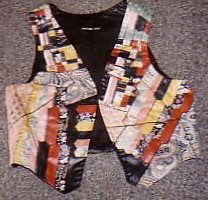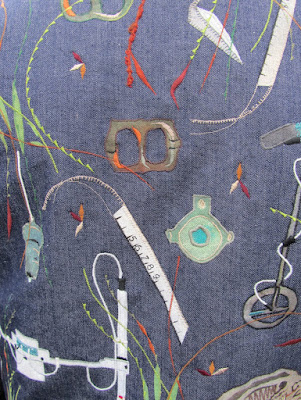At this time of year I am reminded of "The Christmas Quilt" created in 1988. I take it out of the ottoman and drape over the mermaid coffee table. With so many stitches in one piece of work can't fail to stir memories of its creation. The Christmas Quilt pattern was born out of an earlier work sewn in the 1970's (see image below) The plan was to replicate some of the design using beautiful glazed cotton chintz fabric called "Cambridge" from Peter Jones in Sloane Square. At the time I was working in London but commuting each week to Torquay. Lots of hours on coaches and sometimes trains. Sewing commenced once out of Heathrow until Exeter or vice versa. In those days generally a three hour coach ride, trust me, this journey was a welcome respite from the hectic pace of London work and living.
Memories of leaving Victoria Station in twilight or dark, sitting on the top deck of the 501, the coach would stop and start through the Friday night rush hour traffic via Victoria, Embankment, Earls Court, Chiswick and onto Heathrow. This journey provided really good views into houses specially those with lights on. I am sure people must have been aware that travellers could see straight into their homes, it was a fascinating insight. Watching anonymous relaxed people sitting on sofas, hoovering or at the dinner table.
In those days a uniformed hostess wearing a red or blue suit would start service on the 501 after the Heathrow Stop. This was my cue to get the tin of prepared fabric and hexagon papers and start sewing. I set myself targets and pre-planned how many rosettes, straight lines or rounds of hexagons should be sewn on that journey. Travelling light meant no room for extra fabric. I was always mindful that loose cotton, pins and needles should be kept tidy. Accidentally dropping a needle whilst travelling was dreadful, specially if someone was sitting next to me. I always made sure it was found. Often people would want to talk about what I was creating and conversations would be enlightening and lead to other subjects.
"The Christmas Quilt" was idea to sew in portions and the work steadily grew. Once back in London I would lay the work out and plan its next course before the weekend journey. Eventually it all came together. Happy memories of the 501 Coach and creating "The Christmas Quilt"
 |
| "The Christmas Quilt" by Jackie Wills 1988 |
 |
| "The Christmas Quilt" by Jackie Wills 1988 |
 |
| Hexagon Quilt created by Jackie Wills in the 1970's which inspired "The Christmas Quilt" by Jackie Wills 1988 |
Left "The Christmas Quilt" by Jackie Wills 1988
















































